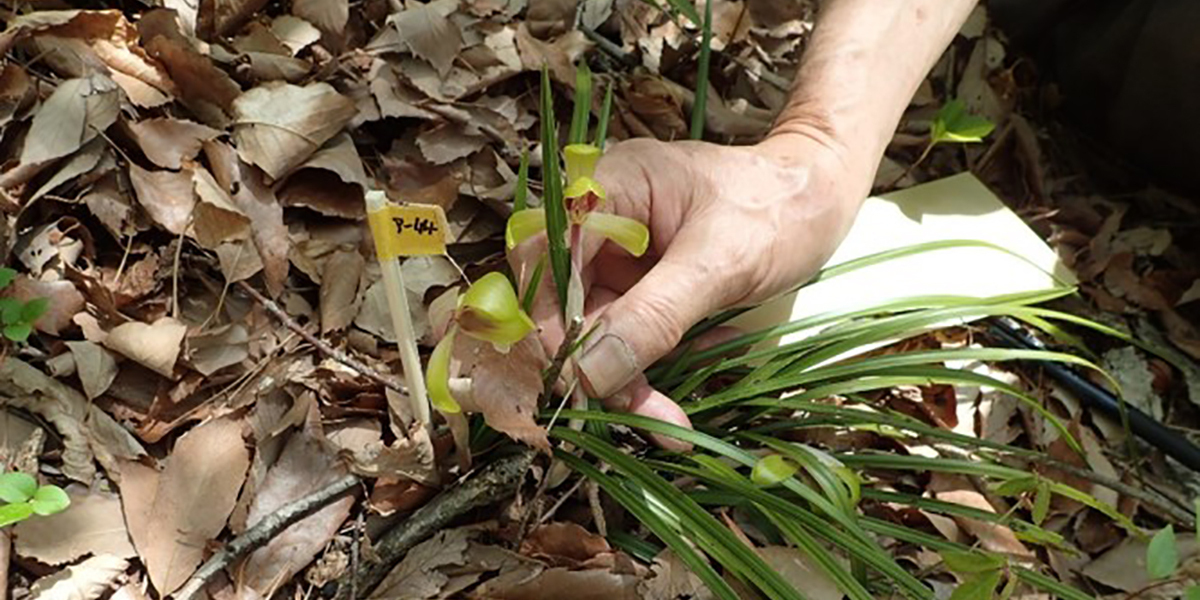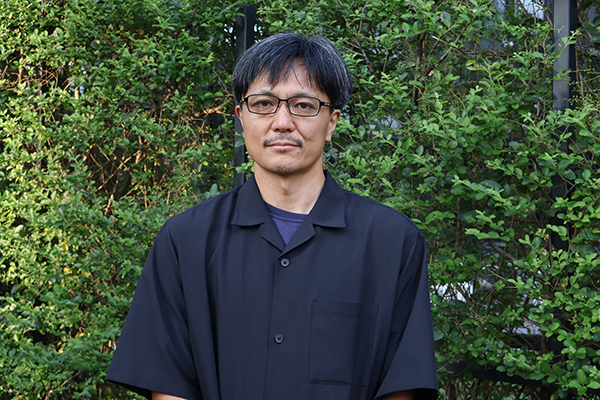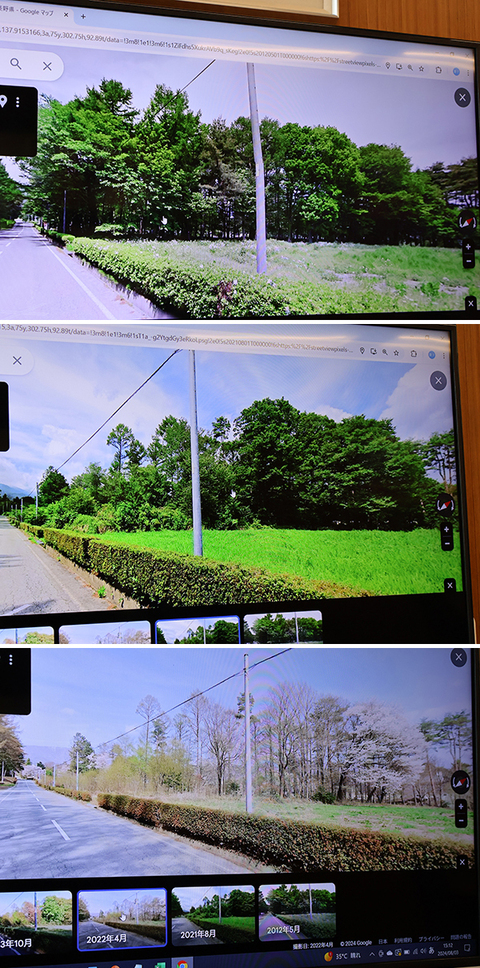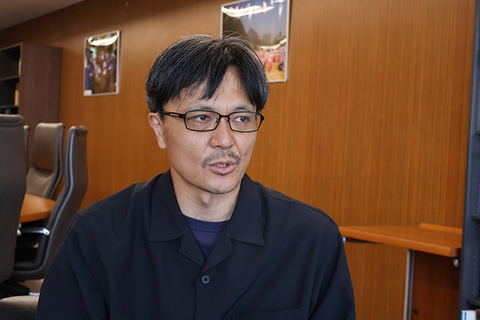update:June 25, 2025
A special interview for the Toyota Foundation’s 50th year anniversary project
A project aimed at stemming a decline in the population of native-grown cymbidium goeringii in Ina City, Nagano Prefecture

Interviewed by Yoko Terasaki and Keiko Kato
Japanese text written by Nobuaki Takeda
Translated by Naoto Okamura
Research shows that flores and plants have been decreasing in number due to a variety of factors such as urban development, global warming, soil degradation, a growing number of foreign species, and over-inoculation of plant virus-controlling vaccines. In fact, the Ministry of Environment’s fourth Red List of endangered and threatened wildlife species, the fifth revision, states that 31% of vascular plants has gone extinct. Cymbidium goeringii in Satoyama forests across Japan has yet to become extinct, but its population has been shrinking. This type of orchid grows natively in Satoyama forests in Ina City, Nagano Prefecture, but the area of its distribution has shrunken at present. Satoyama forest management will help sustain the growth of cymbidium goeringii. To do that, science-based management methods should be pursued and promoted.
In 2015, the Toyota Foundation made a grant to the project titled “Development of Management Methods to Conserve Cymbidium Goeringii in Satoyama: Clarification of its inhabiting processes and scientific verification after improvement of Satoyama by tree thinning.” In an interview, we asked Dr. Hiroyuki Kurokochi, who belonged to the Department of Forest Science, the Graduate School of Agriculture and Life Sciences, the University of Tokyo, at the time of his grant reception, about he conducted research focused on Satoyama forests.
Details

- Program
- 2015 Research Grant Program
- Project Title
- Development of Management Methods to Conserve Cymbidium Goeringii in SATOYAMA: Clarification of its inhabiting processes and scientific verification after improvement of SATOYAMA by tree thinnin
- Grant Number
- D15-R-0091

- Grant Period
- May 2016 to April 2018
- Abstract of Project Proposal
- The management of Satoyama -- a Japanese term referring to a forest area located close to rural residential districts -- by citizen groups and other organizations requires that scientific evidence-based management methods be pursued and promulgated in order to ensure various functions of Satoyama forests. To help create a Satoyama environment cherished by local communities in the Kamimaki district, Ina City, Nagano Prefecture, this research project aims to establish a technical method necessary for growing forests well-suited to propagating cymbidium goeringii or noble orchid, a type of orchids that bear beautiful flowers in early spring and represent a typical forest floor plant in a light-flooded, traditional Satoyama environment.
Satoyama forests left abandoned aggravate the natural environment
Dr. Kurokochi, who comes from nature-abundant Nagano Prefecture, engaged in forest ecosystem research when he received the grant. But he had been looking for a research theme that is socially applicable while working on basic research. “Japan has 70% of its national land covered by forests, and ignoring that fact seems to be out of the question to me as a Japanese. While there has been a recent trend in placing much importance on forests, I have also felt doing basic research alone is not enough to spread that recognition of environmental importance widely to the public,” he said. “Therefore, I wanted to continue research while seeking to create a new value.” As such, he thought about a new value-creating initiative so as to get more people interested in forests.
What’s more, Dr. Kurokochi has been well aware of the importance of looking at research from a broader perspective and the focus of his research goes beyond forestry. “When I was doing this research under the grant, I was also researching marine ecology in the Philippines and elsewhere. I was working on things related to a continuous cycle of ecological system from upriver to downriver, from mountains all the way down to the ocean,” he said, adding that he conducted surveys in China and Indonesia as well.
As he was searching for a research theme, his former teacher in high school asked him if he could do something with Satoyama forests in the teacher’s local community, which led him to do research in Ina City. At the time, a declining population and other problems were raising the issue of abandoned Satoyama forests.
Then, the question is why he has focused on cymbidium goeringii. This has to do with one of his past research subjects: Matsutake mushroom. “Forest management alone is not enough to mobilize people. But involving a well-known food ingredient like Matsutake generates more interest among people. Well-managed, Matsutake-growing mountains have an appropriate amount of sunshine coming through and their soils are not lacking in nutrients so much. It varies from region to region, but mountains that are well-managed and capable of producing Matsutake are suitable for growing cymbidium goeringii,” he said.
Forests, if not managed properly, will help the growth of trees, blocking beams of sunshine reaching the lower areas and affecting the ecology of plants and animals that are supposed to inhabit there, Dr. Kurokochi explained. There are those who log low trees for making firewood in Satoyama forests, which in turn helps let sunshine into lower areas of the forests and create a more well-balanced natural environment. There are some Satoyama forests around the Ina Kita elementary school, but the population of cymbidium goeringii there was said to be decreasing. “So, I suggested to local people concerned that those Satoyama forests should be better managed in such a way as to let more sunshine come through and improve the condition of overly nutrient-rich soil, which may create an environment conducive to the growth of orchids,” he said.
He then came up with an idea of trying to manage Satoyama forests in collaboration with a local elementary school, seeking to take a step closer to doing research that can be socially applicable. “I am a layperson when it comes to doing something together with children, but even with that in mind, I wanted to do research that would become something of a litmus test,” he said.
For children to learn that trees are okay to cut for utilizing forests properly, Dr. Kurokochi makes sure that they are given a chance systematically to witness 20- to 30-meter-high trees being cut down at least once during their six years in school. Children get a chance to learn that making a change to the natural environment through logging allows for the growth of new living things, and they also get to use chopped wood to cultivate mushrooms.
As such, he has been working closely with local people in the municipality to carry out such activities enabling children to experience firsthand the cycle of a new ecosystem triggered by logging.
Elementary school children becoming experts

This research is made possible only with the help of the Ina Kita elementary school. In the first year, the fifth-grade and six-grade students engaged in this research by using some hours of their integrated studies class. But the burden on them turned out to be greater than initially expected. From the second year, Dr. Kurokochi enlisted cooperation only from a single six-grade class to collect various sets of data.
But later on, there was a change in the school’s principal and the burden became too much for the teachers involved to incorporate this research initiative into the school’s curriculum. Even so, he believes that the research themed on forests carries much significance in today’s world where everyone must live in harmony with the natural environment. “I felt that this approach could create a common place where citizens can take various issues as their own. What I did with the elementary school in Ina City has led me to believe I could develop that into an educational program if I were given a chance to continue,” he said.
The biggest hurdle to this project has turned out to be different stances between himself and other people. Dr. Kurokochi admits that he was under so much pressure to collect an amount of data necessary for writing an academic paper for his individual research that he could not afford to pay as much attention to children. Meanwhile, the school teachers wanted to give the students a chance to experience working with a university researcher. “They had a different level of expectations than mine. That’s probably why it must have been stressful for the teachers as well. Unless you understand such different expectations associated with different positions, I now know a research program like that would not work,” he said.
In retrospect, he thinks he should have not pushed too much what he considers is an effective way of doing things. “At initial stages, I was so eager to work very closely with them, which was personally gratifying but was not necessarily the case with the people of the school. I think I could handle it more smartly now,” he said admittedly. He was still young at the time and didn’t know any better, but that biter experience helped him grow mature as a researcher.
He also harbored another thought: back in those days, researchers would often come under criticism if they fail to deliver results. But he wanted the children to experience feeling okay even though they were unable to produce research results. “It is not at all embarrassing even if you can’t deliver results. As long as you find it interesting to do research and survey, I hoped they would continue to do so into the future,” Dr. Kurokochi said.
Indeed, those elementary school children appeared to be having fun working on this project. “When we held a presentation on our research outcomes, the school principal told me that the project created a light-hearted atmosphere and shined rays of light into the forests, bringing light into both the classroom and the Satoyama forests,” Dr. Kurokouchi said with a soft smile. One staff member of the Toyota Foundation saw the children’s presentation in person and said she was taken aback by the level of vocabulary the elementary school students used and the fact that their presentation seemed so authentic. Despite some difficulty, this joint research did encourage their growth. If any forestry researcher were to emerge in the future from among these elementary school children, that would be an ideal outcome. This project has helped sow the seeds of that possibility.
From academia to the private sector

Currently, Dr. Kurokouci continues his research at Asahi Quality & Innovations, Ltd. (AQI), an independent research and development subsidiary that was created in 2019 with advanced research functions and is under the Asahi Group Holdings, Ltd. Since AQI has been managing its own forests for decades, the company’s concept is a perfect match for Dr. Kurokochi’s research even in terms of his pivot from the world of academic to the private sector for conducting his research. “While I do some short-term research, I’d rather put more weight on long-term research. That is my stance. There is a project with a span of 30 years into the future,” he said. “As we are part of the Asahi beer group, we talk about barley, which has large areas for planting. So, I feel it is easier to expand the acreage.”
One might wonder why he has decided to shift to the private sector from the world of academic. In the early 2000s, Dr. Kurokochi enrolled in the University of Tokyo, and it was around the time when the United Nations Conference on Environment and Development (UNCED) adopted the Convention on Biological Diversity (CBD) in 1992. He assumed that efforts for biodiversity would be promoted smoothly if academic institutions including universities tried to disseminate such information. “Today, initiatives such as the Taskforce on Nature-related Financial Disclosures (TNFD) and the Task Force on Climate-related Financial Disclosures (TCFD) are known. But when I received the grant, I didn’t expect businesses to take up the issue as much as now,” he said. “Such research itself can be conducted by universities. As times have changed, it seems that involving businesses can create more potential for expansion. Besides, a life dedicated only to academia would not be appealing enough, so I am grateful for the opportunity to do research in the private sector.”
Dr. Kurokochi also said of the advantages of the role of the private sector. “Impacts of global warming and other factors have increasingly highlighted the importance for corporations to make social contributions rather than pursue only profits,” he said. “Now that we see growing calls for the TNFD and other efforts, once big companies start taking action, I am more hopeful that the things that we thought would remain unchanged for 10 to 20 years may actually change. When I sense that speed of change, I hope that companies will spread such momentum by using their strengths.”
Seeking how to increase food self-sufficiency
Looking ahead, Dr. Kurokouchi hopes to do something about boosting Japan’s food self-sufficiency. “When we think about the environment, it is intertwined with self-sufficiency. Improving the actual environment will help revitalize local communities. Uder-utilization of land will eventually lead to depopulation. If there is a place where some kind of activity is carried out, people will keep coming and going. It would be great to make that happen (with my research),” he said.
Forests help sustain our lives through mitigating global warming, containing water for flood prevention, generating natural resources, preserving the ecosystem for plants and animals, among other ways. Deforestation caused by land development projects and derelict Satoyama forests are clearly detrimental to the earth. Moreover, urbanites do not even have a chance to recognize the importance of forests. Given that, Dr. Kurokochi’s forest research has proven to be significant not just in the short term but also in the long term.
